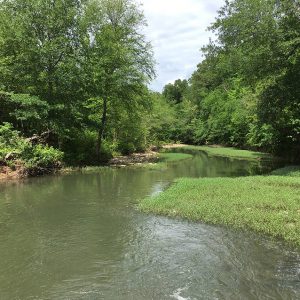calsfoundation@cals.org
Nella (Scott County)
The unincorporated community of Nella is located in southwestern Scott County. It was established in 1903 along Clear Fork Creek, which is a distributary of the Fourche La Fave River. The agriculture and timber industries have traditionally been important economic resources for the community.
Prior to European exploration, the area surrounding Nella was a wilderness. Numerous archaeological sites and burial mounds are located along the banks of prominent waterways such as the Fourche La Fave River. Archaeological findings have provided evidence of early inhabitants dating to the Archaic, Woodland, and Mississippian periods, and the Caddo tribe later inhabited the area.
During the late seventeenth and early eighteenth centuries, French hunters and tradesmen traveled west from Arkansas Post exploring portions of western Arkansas. These Frenchmen often traversed rivers and streams throughout the region. Several rivers that flow through Scott County were likely named by these French explorers, including the Petit Jean, Poteau, and Fourche La Fave rivers. It is probable that they traveled along the Fourche La Fave River or Clear Fork Creek near present-day Nella.
The community of Nella was once known as Gist Town, receiving its name from the Gist family who settled in the area between present-day Nella and Blansett (Scott County). Tom Gist came to the area from Georgia around 1840. He later established two farms in the area and also operated a horse-powered cotton gin. Gist had three sons: John (known as Bud), Joe, and Jim. John married Liza Richmond; after she died, he married Marthy Livesay. His son Jim was killed in a gunfight near Ross Creek. Tom also had two daughters who married two brothers by the name of Wood from the area. Gist was one of the earliest settlers in Nella. Additional early settlers in Nella include the Richmonds, Wilsons, Freemans, Taylors, Browns, Woods, Stars, Whisenhunts, and Churchills.
In 1872, a church was organized at Shiloh (Scott County), about one mile from Nella, and named the Landmark Baptist Church. Though the church was not directly within the Nella community, it was likely attended by residents of Nella. Whisenhunt Cemetery located just north of Nella was one of three cemeteries established near the town. The cemetery was established circa 1870 and named for the Whisenhunt family who settled there and donated the land for it. Additionally, Wilson Cemetery, located south of Nella, was established by the Wilson family who settled near Nella. The cemetery was established circa 1870.
The Shiloh Cemetery near Nella was also used by the town’s citizens. The oldest known grave in the cemetery dates to 1880; however, it is probable that it was established prior to then.
In May 1882, the Scott County Courthouse burned, thus destroying all records that defined the boundaries of the various school districts that had been established throughout the county. Several months later in August, the county court reestablished the boundaries of the fifty-six school districts active in the county; however, Nella School District, No. 48, was not formed until 1890 when Shiloh School District, No. 18, was split into two school districts. Nella School District was later reformed as White Oak sometime between 1897 and 1900.
In 1895, the Landmark Baptist Church was renamed Shiloh Missionary Baptist Church. Reverends Hall, Patterson, Watkins, Windham, and Sheldon were some of its early pastors. Rev. Sheldon reportedly rode a horse from Polk County and carried a gun to protect himself from wild animals. Another pastor allegedly rode in a steer-drawn sled sixteen miles from his home to the church.
In 1890, the Fars Chapel School was reestablished at Nella as School District No. 48. Two years later, the Nella School was consolidated with Shiloh School District.
The town of Nella received its first post office in 1903, with Jeff D. Allen as the postmaster. The town’s name shifted from Gist Town to Nella likely near the time the post office was established. It is not recorded how the town’s name originated, although “Nella” is “Allen” spelled backward. During Nella’s early years, a steam-powered cotton gin sat on the banks of Clear Fork Creek. The gin was located just east of the school house. In 1907, James and Ella Ray donated a tract of land that would be used by the Methodist Episcopal Church. They soon constructed a church on the grounds; it later burned down and was never rebuilt.
Jim Ray owned and operated a store at Nella in the early twentieth century. Jess Brown was one of the earliest blacksmiths in Nella. Tom Rose operated another blacksmith shop from 1923 to 1948.
Several members of the Nella community were drafted to serve in World War II.
Nella received electricity in the early 1950s. The Nella Post Office was discontinued in 1953, with the mail being sent to Eagleton (Polk County). After World War II, Nella’s population began decline, mostly due to the consolidation of schools, the loss of jobs within the timber industry, and the growth of nearby Waldron (Scott County).
In the twenty-first century, Nella is still an agricultural community. The Shiloh Church and Cemetery continue to be used by residents living in the area. The last burial in Whisenhunt cemetery was in 1973; however, the cemetery’s grounds are still maintained. Wilson Cemetery has likewise gone unused since 1964 but is maintained by a caretaker. Hunting and fishing continue to be popular activities among residents.
For additional information:
Biographical and Historical Memoirs of Western Arkansas. Chicago: Goodspeed Publishing Company, 1891.
Cate, Michael. History of Scott County, Arkansas. Dallas, TX: Curtis Media Corporation, 1991.
Goodner, Norman. A History of Scott County, Arkansas. Siloam Springs, AR: Bar D Press, 1941.
McCutcheon, Henry Grady. History of Scott County, Arkansas. Little Rock: H. G. Pugh and Company, 1922.
Ty Richardson
Richardson Preservation Consulting
 Clear Fork Creek
Clear Fork Creek  Nella Baptist Church
Nella Baptist Church  Nella VFD
Nella VFD  Scott County Map
Scott County Map  Shiloh Cemetery
Shiloh Cemetery  Whisenhunt Cemetery
Whisenhunt Cemetery 



Comments
No comments on this entry yet.